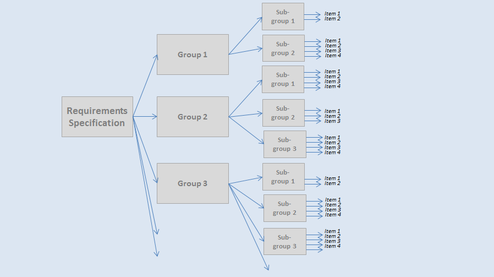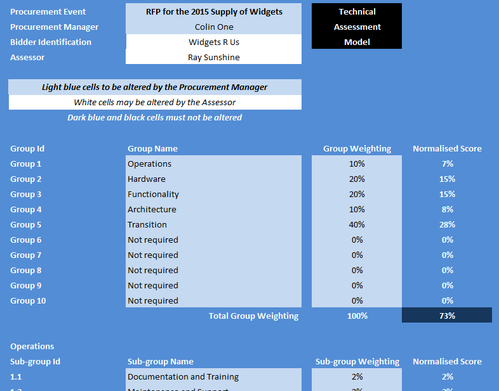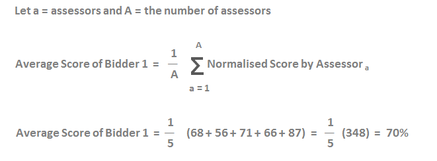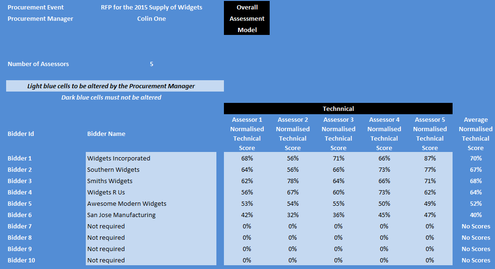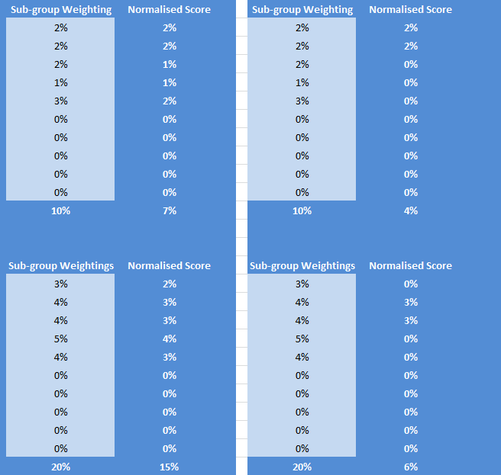Introduction
The Problem Statement
The model allows for a dual weighting to be applied, where the first weighting is of the Groups / Sub-groups and the second is of the Items. Each assessor completes an assessment by rating the performance of a given bidder against all of the active criteria. The model calculates a percentage value which is the score for that bidder by that assessor. This can be seen in the figure below where the normalised score for Widgets R Us by Ray Sunshine is 73%.
In this straight forward case, it’s a matter of simply averaging the normalised scores.
All Full Assessments
One-or-more Partial Assessments
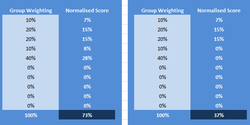 Figure 4 – Complete Assessment on the Left and Partial Group Assessment on the Right
Figure 4 – Complete Assessment on the Left and Partial Group Assessment on the Right As an experienced Procurement Manager I would be very reluctant to allow an assessor to leave me with an incomplete Sub-group assessment. As a Sub-group is highly likely to cover criteria within a single skill set, there is little excuse for not assessing all Items within a Sub-group. If the problem can’t be resolved favourably, the section below entitled Other Alternatives may be of some use.
Partial Group Assessment
Using the example shown in Figure 2, let’s assume, for simplicity of explanation, the first four assessors complete full assessments and the fifth assessor completes an assessment of only Groups 1 to 3. The following figure shows the results of Assessor 1 on the left and those of Assessor 5 on the right.
It works like this. If all five assessors had completed 100% of the assessment each, we would divide the sum of their normalised scores by five. If only four assessors had completed 100% of the assessment each, we would divide the sum of their normalised scores by four. In this case we have four assessors completed 100% of the assessment each and one assessor completed only 50% of their assessment (10% + 20% + 20% from the Group Weighting column), we should then divide the sum of the normalised scores by 4.5. If the fifth assessor had completed only the first two Groups (10% + 20% = 30%) we would divide by 4.3.
The general form of the solution is as follows:
e.g.
Use Another Assessor
Let’s say for example an assessor was determined to make an assessment on Items 3 to 6 in Sub-group 1 of Group 2 but wished to make no other contribution. It may be possible to find another assessor who would be willing to forego their assessment of Items 3 to 6 in Sub-group 1 of Group 2, thus maintaining a full integer in the general form of the solution.
Share an Assessment
If a number of assessors wish to carry out partial assessments, set aside one Assessment Model for partials only and make sure that you know how much of the 100% has been assessed.
General Form
Use the general form of the solution about. It will work for any combinations however there is an effort required by the Procurement Manager to determine the percentage in the denominator for each partial assessment.
Other Alternatives
The situation where one or more assessors completes a partial Sub-group is virtually the same as above with the slight complication that the Procurement Manager needs to quickly calculate what percentage of the full 100% has been calculated by looking at the Overview Worksheet.
Using the example shown in Figure 5, let’s assume, the first four assessors complete full assessments and the fifth assessor completes an assessment of only Groups 1 to 2 and within Group 1 completes only Sub-groups 1 and 2 and within Group 2 completes only Sub-group2 2 and 3. The following figure shows a complete assessment on the left and the incomplete assessment on the right.
Conclusion
1/ Assessing less than the full amount of Groups and Sub-groups is fine but Sub-groups should not need to be split.
2/ The general form of the solution always works and is as follows:
